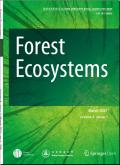冰风暴后邻里关系对法桐-白叶松林树木生长的影响
IF 3.8
1区 农林科学
Q1 FORESTRY
引用次数: 0
摘要
冰风暴会对树冠造成严重破坏,导致生长量减少。然而,在树龄不均的林分中,由于邻近树木受损或死亡导致树冠释放,单棵树木的生长也可能会增加。在克罗地亚迪纳拉混交不均龄林2014年毁灭性冰风暴三年后,我们对20个永久样地中的156棵欧洲山毛榉(Fagus sylvatica)和85棵银冷杉(Abies alba)进行了取样,研究风暴后的生长反应与树木、林分、地点、空间布局和当地竞争因素的关系。冰风暴损坏了取样地块上 84% 以上的树木。在被取样的树木中,52.7%的树木生长量减少,与受干扰前的平均值相比,平均减少了-3.1%。树冠受损率低于 40% 的树木则保持了干扰前的生长速度,或仅受到轻微的生长抑制。60%的山毛榉树的生长率平均下降了-7.2%,而杉木在暴风雨后的平均径向增量比暴风雨前增加了14.0%。线性混合效应模型表明,生长反应在很大程度上可以用焦点树种和邻近树种的特性、树木竞争压力、焦点树种和邻近树种的损害、树冠大小、细度指数和石质来解释。生长释放与枞树、最近邻居的反距离加权树冠损害、较短的树冠、细长度、石质较少的地点和受损较轻的树木呈正相关。分析表明,在当地竞争负荷水平相同的情况下,近邻为阔叶树且树冠受损的树木比近邻为针叶树或树冠未受损的树木更有可能经历生长释放。这意味着,针叶树和阔叶树大量混生的不均匀树龄林木对冰风暴的抵抗力更强,更不可能出现生长量减少的情况。本文章由计算机程序翻译,如有差异,请以英文原文为准。
Neighborhood effects on tree growth in a Fagus sylvatica - Abies alba forest following an ice storm
Ice storms can cause substantial damage to tree crowns and lead to growth reduction. However, in uneven-aged stands, the growth of an individual tree may also increase due to crown release caused by the damage or mortality of neighboring trees. Three years after the devastating ice storm in 2014 in mixed uneven-aged Dinaric forests (Croatia), we cored 156 European beech (Fagus sylvatica) and 85 silver fir (Abies alba) trees across 20 permanent sample plots to study the post-storm growth response as a function of tree, stand, site, spatial arrangement and local competition factors. The ice storm damaged over 84% of trees on the sampled plots. Among the cored trees, 52.7% exhibited growth reduction, which on average amounted to −3.1% relative to the pre-disturbance average. Trees with less than 40% crown damage maintained their pre-disturbance growth rates or experienced only minor growth suppression. While 60% of beech trees suffered a growth reduction at an average rate of −7.2%, the average radial increment of fir after the storm was 14.0% higher compared to the pre-storm rate. A linear mixed-effects model suggests that the growth response can largely be explained by the focal and neighboring tree species identity, tree competition pressure, focal and neighboring tree damage, crown size, slenderness index and stoniness. Growth release was positively associated with fir, inverse distance-weighted crown damage of the nearest neighbor, shorter crowns, slenderness, less stony sites and less damaged trees. The analysis suggests that at the same level of local competition load, trees with a broadleaved and damaged nearest neighbor are more likely to experience growth release than those with a coniferous or undamaged nearest neighbor. This implies that uneven-aged stands with a substantial presence and mingling of both conifers and broadleaves are expected to be more resilient to ice storms and are less likely to suffer growth reduction.
求助全文
通过发布文献求助,成功后即可免费获取论文全文。
去求助
来源期刊

Forest Ecosystems
Environmental Science-Nature and Landscape Conservation
CiteScore
7.10
自引率
4.90%
发文量
1115
审稿时长
22 days
期刊介绍:
Forest Ecosystems is an open access, peer-reviewed journal publishing scientific communications from any discipline that can provide interesting contributions about the structure and dynamics of "natural" and "domesticated" forest ecosystems, and their services to people. The journal welcomes innovative science as well as application oriented work that will enhance understanding of woody plant communities. Very specific studies are welcome if they are part of a thematic series that provides some holistic perspective that is of general interest.
 求助内容:
求助内容: 应助结果提醒方式:
应助结果提醒方式:


